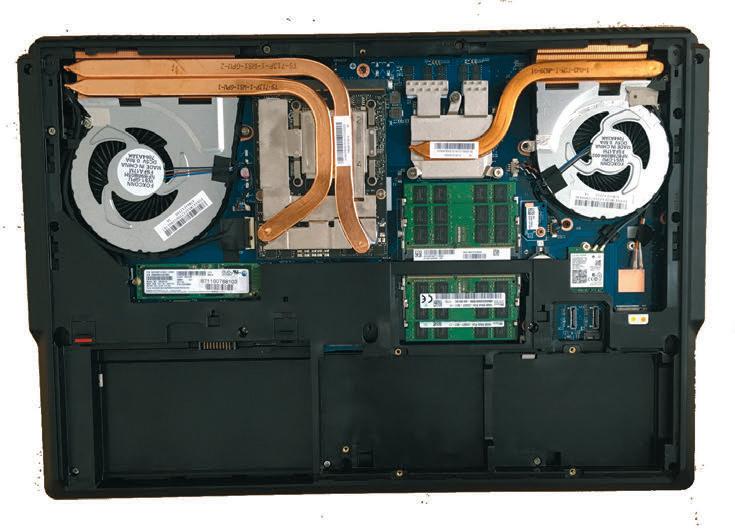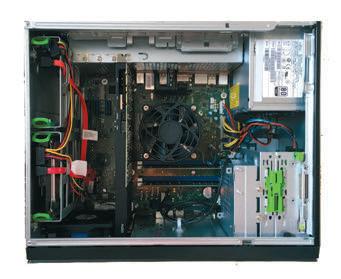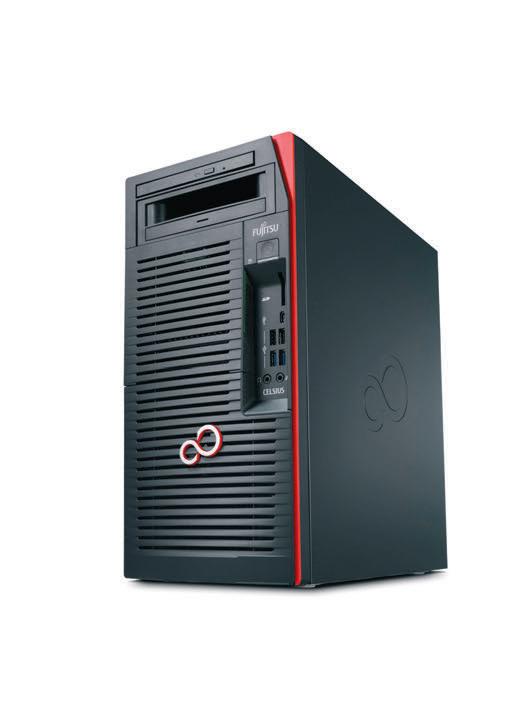
13 minute read
Workstations
Fujitsu Celsius H970
Fujitsu’s new 17.3-inch mobile workstation offers incredible power for demanding VR and viz workflows but the CPU cooling fan can be a little over eager at times writes Greg Corke
For some years now, Fujitsu has been relatively inactive on the mobile workstation front. Most OEMs offer three or four different models (HP actually has six), but until recently, the German-based manufacturer only had a single mobile workstation – a 15-inch machine. 15-inch mobile workstations are fine for 3D CAD, but they can only support a midrange GPU, so often fall short in more challenging 3D workflows. Historically, demand has come from users of traditional design viz applications like 3ds Max or Maya (and perhaps a little cheeky gaming after hours). However, more recently, the need for a more powerful GPU has come from additional areas including game engine visualisation, GPU rendering andVirtual Reality (VR).
In order to support these new designfocused, GPU-hungry workflows, Fujitsu has added a 17-inch mobile workstation to its portfolio — the Fujitsu Celsius H970. The larger chassis provides the thermal headroom needed for a significantly more powerful GPU, as well as accommodating a bigger display.
The Celsius H970 comes with a choice of three pro-grade GPUs. The Quadro P4000 (8GB) and P5000 (16GB) are both powerful, VR Ready and virtually identical to their desktop counterparts. Alternatively, for those who want the benefits of a larger screen but don’t necessarily need buckets of GPU power, there’s the Nvidia Quadro P3000 (6GB). To put all of this into perspective, most 15-inch mobile workstations are limited to the 3D CAD-centric Nvidia Quadro M2200 (4GB), which is a whole GPU class below.
To show off its peak capabilities, our test machine came with the top-end Quadro P5000. This 100W GPU is partnered with a more mainstream CPU – the Quad Core, Intel Core i7 7820HQ (2.9GHz - 3.9GHz Turbo), common in both 15-inch and 17-inch mobile workstations. For those that need a bit more oomph, the H970 can also accommodate the Intel Xeon E3-1535M v6 (3.1GHz – Product spec The chassis is solid, a combination of metal and plastic, and 4.2GHz Turbo). ■ Intel Core i7-7820HQ features a full-size keyboard Memory is maxed out at 64GB of 2,133 MHz DDR4, distributed over four 16GB (2.9GHz - 3.9GHz Turbo) (4 Cores) CPU ■ 64GB (4 x 16GB) 2,133 MHz DDR4 with numeric keypad. It is somewhat let down by the keyboard frame, which flexes a lot SO DIMMs, which is plenty memory in the middle, making it feel for most design workflows. ■ 1 x 512GB M.2 NVMe SSD spongy when typing. However,
For storage, there’s a soli■ Nvidia Quadro Fujitsu says that this was only tary 512GB NVMe M.2 SSD – P5000 GPU (16GB) an issue with early units (like the popular Samsung SM961, ■ 17.3” anti-glare IPS ours) and has now been fixed. also available in 256GB or FHD display (1,920 x 1,080) For security, there’s a stan1TB models. Those who want ■ Microsoft Windows dard fingerprint scanner and more capacity (or a lower cost 10 Pro 64-Bit not the palm vein technology per GB) can add one or two ■ 418 x 288 x 30mm championed by the 15.6-inch 2.5-inch SATA Hard Disk (w) x (d) x (h) Fujitsu Celsius H770. Drives (HDDs), but it seems ■ 3 Year Collect & Return Service At 418 (w) x 288 (d) x 30mm these are best specified at ■ £4,500 + VAT (h), the machine is comparative time of purchase as our test fujitsu.com in size with others in its class. machine did not come with Performance is very impresany mounting brackets or sive, with the Celsius H970 cables – just the space within the chassis. excelling in our GPU intensive bench-
Elsewhere, the Celsius H970 does well marks. We found it to be a worthy partner on serviceability. Memory can be accessed for real-time design viz in Autodesk easily, simply by taking out one screw and VRED Professional, game engine visualilifting up a service panel. sation with Autodesk Revit Live or GPU
The 96Whr Li-ion battery can also be rendering with V-Ray, going toe to toe easily removed by sliding a clip. At a time with Quadro P5000-based desktop when many other OEMs are moving machines. However, under more CPU limtowards fully integrated batteries, it’s nice ited applications like PTC Creo and to be able to carry a spare in the bag for SolidWorks, the graphics performance long journeys. In saying that, battery life dropped because of the lower GHz CPU. is good for a machine of this size, lasting All of our tests were done at FHD, which is the maximum resolution of the integrated 17.3-inch antiglare IPS display, which is crisp and of good quality, if not outstanding. Other OEMs offer optional 4K displays, which is important for some design viz users, although you can expect frame rates to drop at higher resolutions, especially in GPUhungry applications. We also tested the Celsius H970 with some professional VR applications, using an Oculus Rift headset. In Autodesk Revit Live, we had a comfortable experience navigating our test buildings and we’d expect the same of other game engine VR applications. In Autodesk VRED Professional, our automotive model appeared fine at lower quality settings, but 108 frame rates fell to uncomfortable levels as mins in soon as anti-aliasing was enabled. the CPU and GPU intensive PCMark At this juncture, it is worth mentioning benchmark — and much longer in more the ports on the Celsius H970, as there balanced workflows. are some differences to other machines in
Access to the drives and fans (if needed its class. for cleaning) is more involved, but it only First, there are only three USB 3.1 Gen1 takes a matter of minutes to remove the (Type-A) ports (other manufacturers offer main maintenance panel, which is four) so you can quickly run out when secured with a few screws. using VR. The Oculus Rift, for example,
needs four (for headset, tracker, touch and Xbox wireless controller), and that’s before you start adding other devices like a smartphone or a 3D SpaceMouse.
However, the H970 also has two USB 3.1 Gen2 (Type-C)/Thunderbolt 3 ports, so Type A adapters or hubs can get round this potential issue.
Second, there is no HDMi (only DisplayPort and VGA) port, which is the primary display interface for the Oculus Rift and HTC Vive.
Neither of these quirks are deal-breakers, as long as you have the appropriate adapters to hand.
Like most mobile workstations, the H970 features two fans for cooling – one for the GPU and one for the CPU. When hammering the GPU with a GPU renderer or with a VR application, we found fan noise to be significant but not that loud. However, with all four CPU cores working flat out on a KeyShot render, noise became much more noticeable. The CPU fan even started whirring under more moderate loads, which some will find annoying.
Overall, the Fujitsu Celsius H970 is a hugely powerful mobile workstation, capable of making light work of demandSamsung Portable SSD T5
Samsung’s new portable drive offers fast, secure SSD storage in a sleek package.
When using external storage for shunting large CAD datasets around, performance often gets overlooked. USB Hard Disk Drives (HDDs) peak at around 130MB/sec and grind to a halt when you try to copy data in parallel from two or more sources. Most USB thumb drives are shockingly slow, sometimes taking tens of minutes just to copy a few gigabytes of data.
If you’re fed up with waiting for your data, then it’s time to start thinking about an external Solid State Drive (SSD) and the Samsung Portable SSD T5 is a great example. It boasts read/write speeds up to 540MB/sec and is available in four capacities: 250GB (£125), 500GB (£186), 1TB (£375) and 2TB (£739). It has a sleek metal rounded unibody design, weighs just 51g and comes with both USB Type A and Type C cables to support USB 3.1 Gen 2 as well as older USB interfaces.
We tested read/write speeds over USB 3.1 Gen 2 with three real world 3D datas1
3

5
ing viz or VR workflows. Battery life is good and the ability to swap out for a spare is a big plus for those who spend time away from their desk. However, the machine is let down a bit by a CPU cooling system that is over-eager at times. ets from Revit, 3ds Max and SolidWorks.
The drive came formatted to exFAT so it can work on multiple operating systems, but we reformatted it to NTFS as it is known to give better performance, particuarly with small files.
We immediately saw an improvement in read/write speeds of up to 12% when copying our 8.2GB SolidWorks dataset, which comprises 14,000 CAD parts and assemblies. Because the files are relatively small (50k to 60MB) speeds averaged 105MB/sec read and 90MB/sec write.
Transfer rates increased signifcantly when copying larger files. With 68 Revit files, totalling 4.6GB, read performance averaged at 396MB/sec and write performance 335MB/sec.
Our 3ds Max dataset offers more of a mix, comprising 60 large scene files and 4,400 smaller materials, totalling 4.6GB. It ripped through the scene files, but slowed down with the materials, averaging 246GB/ sec read and 217GB/sec write. 4 2
6
1 CPU cooling fan 2 GPU cooling fan 3 M.2 NVMe SSD 4 Memory (4 x SO DIMMs) 5 Location of removable
battery 6 Location of 2.5-inch HDDs
Acknowledging that not everyone has a workstation with USB 3.1 Gen 2, we also tested over USB 3.0 with the Type A cable. Performance dropped by 7 – 19% depending on the dataset. This is significant but still fast. Over USB 2.0, expect speeds to fall dramatically – below 50MB/sec.
The T5 is not just about high-speed data transfer. It offers optional AES 256-bit hardware encryption to keep confidential data secure should you lose the drive. This is managed through the bundled software and controlled with a password of your choice (which you simply must not forget as this is military-grade security).
We’re big fans of the Samsung Portable SSD T5. It’s sleek, well built and, unlike a HDD, is protected against accidental drops. The price per GB is high, but it’s a small price to pay if you don’t like waiting for data to copy. It’s certainly a big improvment over an external HDD or thumb drive, but there is only a small performance increase over the previous generation T3 model (tinyurl.com/ SSDT3-AEC).
Greg Corke

Fujitsu Celsius W570power+
This compact workstation not only delivers the goods for 3D CAD but with a powerful GPU, architects and engineers can also take their designs into VR.
The workstation landscape changed dramatically early 2017 with the launch of the Nvidia Quadro P4000. This powerful single-slot GPU suddenly gave the traditional Intel Core i7 or Intel Xeon E3-1200 series CAD workstation a new lease of life by giving it enough 3D graphics performance for entry-level professional Virtual Reality (VR) workflows.
Previously, in order to buy a VR Ready workstation from a major OEM, you needed to invest in a more expensive Intel Xeon E5-based machine.
The Fujitsu Celsius W570power+ is a CAD workstation at heart. All the CPU options, bar two, are quad core and the machine can take a maximum of 64GB or memory. But it’s the optional Nvidia Quadro P4000 GPU that gives designers, engineers or architects a new opportunity to take their CAD designs into VR.
But the Celsius W570+power is much more than just a new CAD workstation with a powerful graphics card. The machine, designed and manufactured in Germany, features an innovative 21-litre space-saving micro tower design. It is the smallest ‘VR Ready’ workstation from a major OEM. Equivalent machines from Dell, HP and Lenovo are some 30% larger.
A key part of the design is that the motherboard and GPU span the entire depth of the machine, so both rear and front I/O ports connect to the chassis without cables. There’s also a recess at the rear of the box, so USB, Ethernet and video cables don’t protrude out of the back of the machine as far as they do in other workstations. The recess doubles as a hand hold and certain models have a
2


dedicated front grip, which quad core Intel Xeon makes it easy to move the Product spec E3-1285v6 (4.1GHz, up to workstation between office ■ Intel Core i7-7700 4.5GHz), right down to the and boardroom, for example, (3.6GHz to 4.2GHz) dual core 3.9GHz Intel Core for VR or design/review. (Quad Core) CPU i3-7100, for those on a very
The Celsius W570power+ is ■ 16GB (2 x 8GB) DDR4 2,400MHz tight budget. actually a special edition memory The machine gave a good model of its sibling, the Celsius ■ 256GB M.2 NVMe account of itself in our singleW570. It features a 400W PCIe SSD + 1TB 7,200 RPM SATA HDD threaded IGES test, exporting power supply so it can power ■ Nvidia Quadro our test model from the 105W Quadro P4000 as P4000 (8GB) GPU SolidWorks in 99 secs. It well as more storage. Incredibly, for a machine of this size, the W570power+ can ■ Microsoft Windows 10 Pro ■ 180mm x 304mm x 375mm (w) (d) (h) delivered our KeyShot render in 669 secs, which is typical of a quad core workstation, but support up to 28TB of storage. ■ 3 years warranty almost five times slower than There can be seven drives in ■ £1,600 + VAT the 18-core, design viz montotal, including three NVMe fujitsu.com ster of a machine that is the PCIe M.2 modules. And 2.5- Scan 3XS WI6000 Viz. inch and 3.5-inch drives can The Quadro P4000 GPU be swapped out passed our 3D tests in quickly using SolidWorks, PTC Creo and Fujitsu’s trademark Revit with flying colours. easy rails. The machine also per-
Our test machine formed well in highcame with the pop- end design viz applicaular combination of tion Autodesk VRED 256GB NVMe M.2 Professional, the SSD for operating AEC-focused game system, applica- engine viz tools tions and current LumenRT and datasets and 1TB Autodesk Revit Live. 7,200RPM SATA However, those workHDD for less fre- ing at 4K resolutions quently accessed may need a more files. The M.2 SSD is powerful GPU like on-board, right next the Quadro P5000 or to the main system fan, and the HDD is 1 P6000. In VR, using an housed in a drive Oculus Rift, we had a bay at the bottom of great experience in the machine. NVMe SSDs are available in Autodesk Revit Live. However, as we capacities up to 1TB, while SATA HDDs have found in previous tests with the up to 6TB. Quadro P4000, ramping up anti-aliasing
The processor submitted for this review on our automotive model in Autodesk is the popular Intel Core i7 7700 which, VRED Professional made the VR experiwith four CPUs cores running at 3.6GHz ence uncomfortable. This is not the (up to 4.2GHz), is well-suited to main- machine for you if you are heavily into stream CAD work. There are plenty of automotive styling. other choices here, including the top-end In summary, the Celsius W570power+ is a great machine for CAD users who also 3 want to support architectural design or product development with real-time design viz or VR. It’s compact, well-built, quiet in operation and, with a price tag of £1,600, also affordable.
Greg Corke

1 The Fujitsu Celsius W570power+ compact chassis features a built-in handle for portability 2 Workstation interior with side panel popped off 3 Rear of machine with recessed back panel gives extra space for USB and video cables










